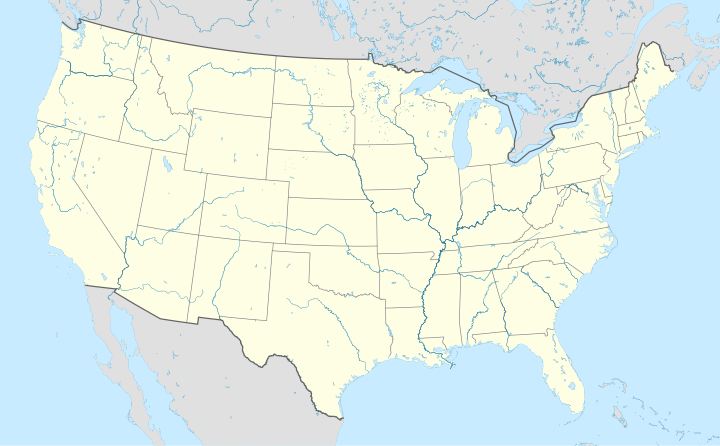Class B is a class of airspace in the United States which follows International Civil Aviation Organization (ICAO) airspace designation. Class B airspace areas are designed to improve aviation safety by reducing the risk of midair collisions in the airspace surrounding airports with high-density air traffic operations.[1] Aircraft operating in these airspace areas are subject to certain operating rules and equipment requirements.[1]
Class B airspace protects the approach and departure paths from aircraft not under air traffic control. All aircraft inside Class B airspace are subject to air traffic control. Traffic operating under VFR must be identified on radar and explicitly cleared into the airspace before they can enter. The airspace is commonly depicted as resembling an "upside-down wedding cake". The innermost ring extends from the surface area around the airport to typically 10,000' MSL. Several outer rings usually surround it with progressively higher floors to allow traffic into nearby airports without entering the primary airport's Class B airspace.
The airspace around the busiest US airports is classified as ICAO Class B, and the primary airport (one or more) for which this airspace is designated is called Class B airport. As of January 2023, there are 37 Class B airports in the United States.[2][3] Despite common misconception, Nellis Air Force Base and Dallas Love Field Airport are not designated as Class B airports; however, in both cases the Class B airspace for the primary airport in the region (Harry Reid International and Dallas/Fort Worth International, respectively) has been specifically extended to cover these airports as if they were themselves Class B.[2]
The following list of Class B airports is sorted by state and IATA Airport Code/ICAO Airport Code.[2]
- PHX / KPHX Phoenix Sky Harbor International
- LAX / KLAX Los Angeles International
- NKX / KNKX Marine Corps Air Station Miramar
- SAN / KSAN San Diego International
- SFO / KSFO San Francisco International
- DEN / KDEN Denver International
- MCO / KMCO Orlando International
- MIA / KMIA Miami International
- TPA / KTPA Tampa International
- ATL / KATL Hartsfield–Jackson Atlanta International
- HNL / PHNL Honolulu International
- ORD / KORD Chicago–O'Hare International
- CVG / KCVG Cincinnati/Northern Kentucky International
- MSY / KMSY Louis Armstrong New Orleans International
- ADW / KADW Andrews Air Force Base
- BWI / KBWI Baltimore/Washington International
- BOS / KBOS Boston–Logan International
- DTW / KDTW Detroit Metropolitan Wayne County
- MSP / KMSP Minneapolis–Saint Paul International
- MCI / KMCI Kansas City International
- STL / KSTL Lambert–St. Louis International
- LAS / KLAS Las Vegas-Harry Reid International
- LSV / KLSV Nellis Air Force Base (lies within the class B surface area of LAS)
- EWR / KEWR Newark Liberty International
- JFK / KJFK New York–John F. Kennedy International
- LGA / KLGA New York–La Guardia
- CLT / KCLT Charlotte Douglas International
Ohio:
- CLE / KCLE Cleveland Hopkins International
- PHL / KPHL Philadelphia International
- PIT / KPIT Pittsburgh International
- MEM / KMEM Memphis International
- DAL / KDAL Dallas Love Field (lies within the class B surface area of DFW)
- DFW / KDFW Dallas/Fort Worth International
- HOU / KHOU Houston–Hobby (class B secondary airport)
- IAH / KIAH Houston–George Bush Intercontinental
Utah:
- SLC / KSLC Salt Lake City International
- DCA / KDCA Ronald Reagan Washington National
- IAD / KIAD Washington Dulles International
- SEA / KSEA Seattle–Tacoma International
See also
editReferences
edit- ^ a b FAA Order JO 7400.2L, Procedures for Handling Airspace Matters, effective 2017-10-12 (with changes), accessed 2017-12-04
- ^ a b c FAA order JO 7400.11B, Airspace Designations and Reporting Points, effective 2017-09-15, accessed 2017-12-04
- ^ Airspace Amendments to FAA Order JO 7400.11B, accessed 2017-12-04
External links
edit- FAA Aeronautical Navigation Products (AeroNav Products), formerly National Aeronautical Charting Office (NACO)
- FAA National Flight Center Data (NFDC)
- SkyVector – geo-referenced online collection of US aeronautical charts
